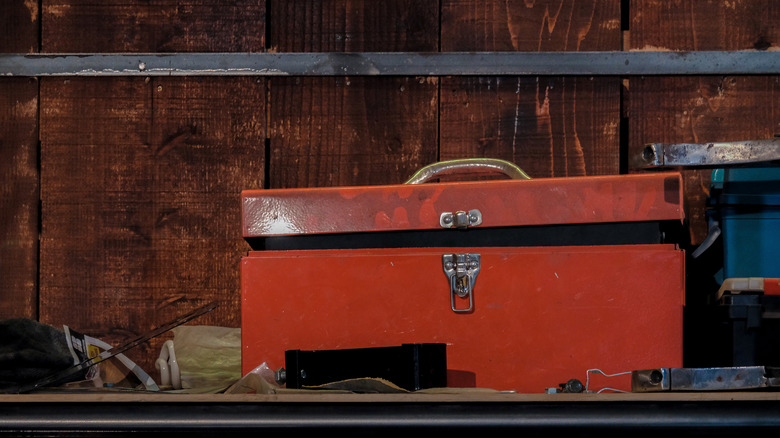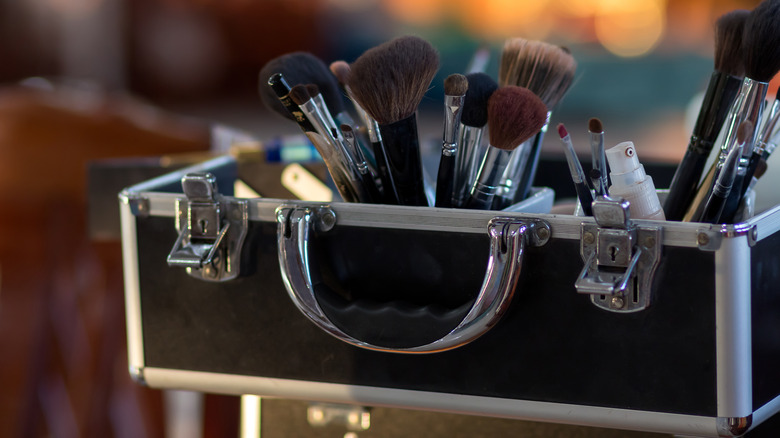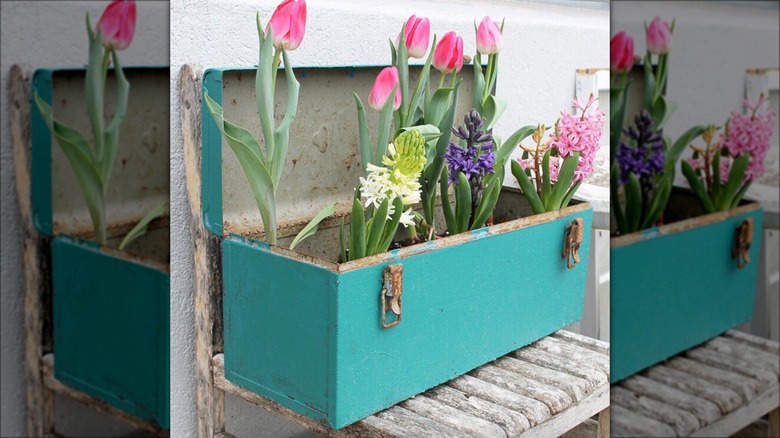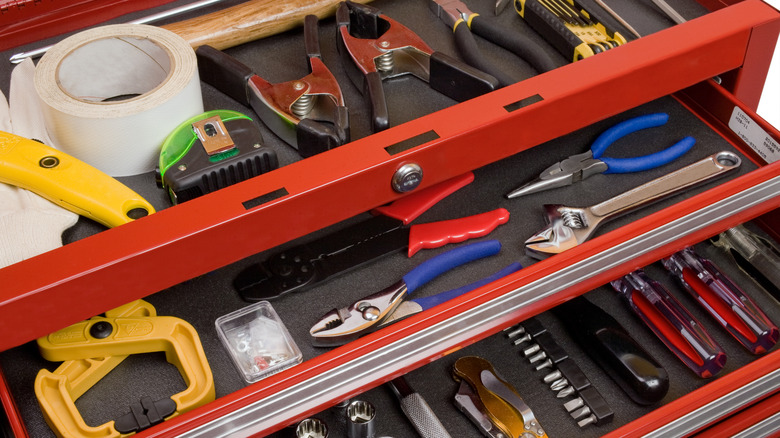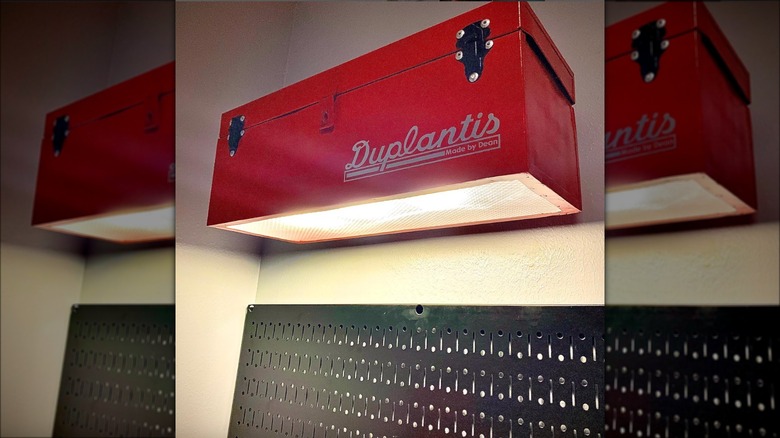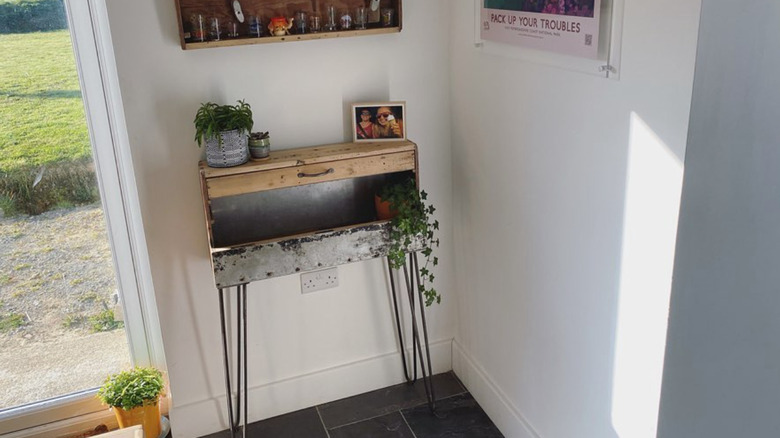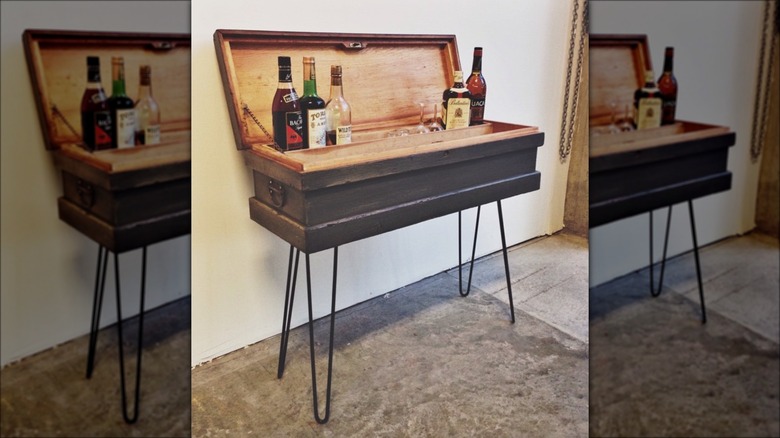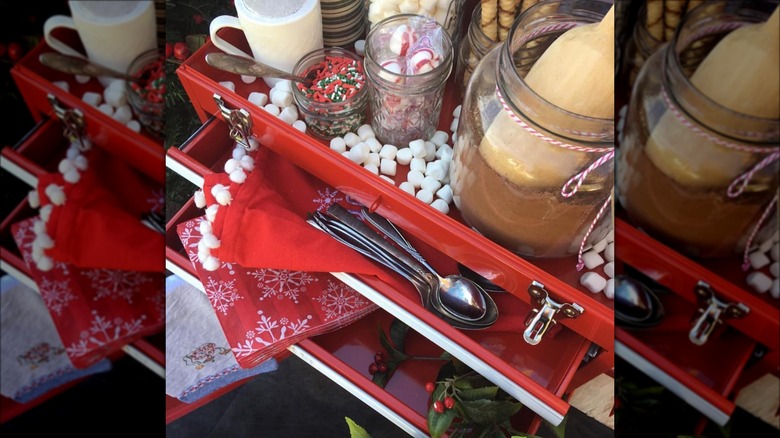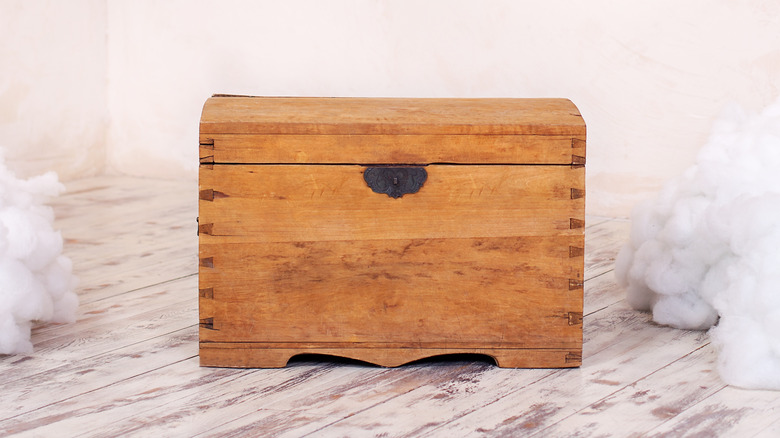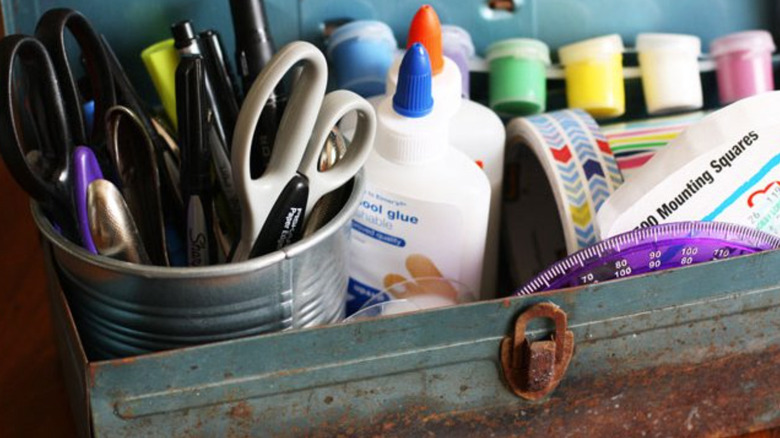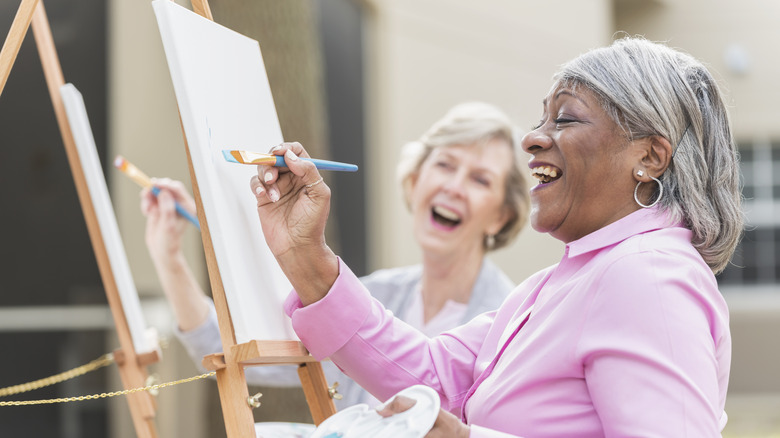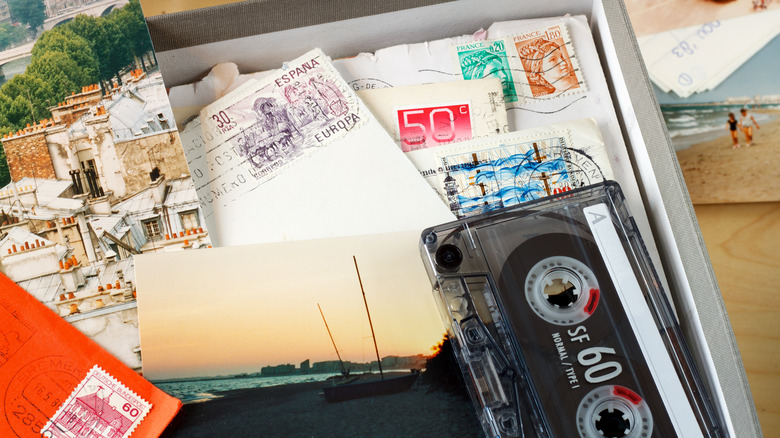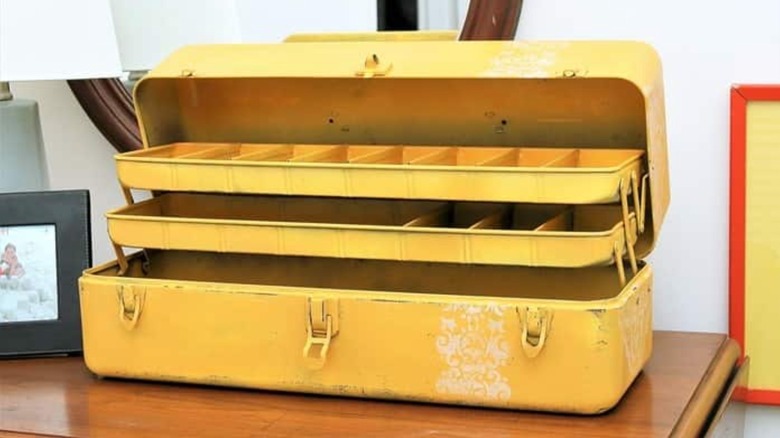All The Creative Ways To Repurpose An Old Toolbox Around Your Home
A classic toolbox, especially one that's well-made and well-maintained, can last for decades, if not generations. Unfortunately, however, there comes a time in every object's life when it needs to be retired. Rusty hinges, deteriorating finish, and inconvenient dents can make for a toolbox that's in less-than-ideal shape, and, in many cases, there's not much you can do to fix it back up. In that situation, however, don't be so quick to toss the old toolbox in the garbage — it can make for a surprisingly versatile base for your next DIY project.
Upcycling, the act of taking an existing object and improving it or transforming it into something else, is a great way to cut back on your family's waste, decrease the amount you spend on materials for your next project, and even repurpose something that's special to you if it's not cut out to serve its original purpose anymore. Despite these benefits, however, only about 21% of people frequently upcycle materials in their homes, according to data from Statista. If you've never tried your hand at upcycling before, consider giving it a shot. You'll likely be surprised at how many different uses you can find around your home and garden for even the most specifically designed products, like an old toolbox.
Makeup storage
Despite their obvious differences in marketing, toolboxes and some of the larger makeup cases available on the market share a lot of the same DNA. If your toolbox is in fair shape but isn't working out for more rough-and-tumble handling, it can make for a great base for a makeup kit. Toolboxes usually have small drawers, removable trays, and divided sections intended to store hammers, drill bits, and tape measures, but nobody says these divisions can't also help to organize your makeup brushes, eyeshadow palettes, and lipstick options as well. Just make sure you give everything a good clean — workshop grime and sensitive skin are a bad combo.
Creative planter
Planters are one of the most common upcycling projects but with results this cute, who is surprised? To make your own toolbox planter, all you need to do is clear out any existing trays and give everything a good wipe-down. Paint the outside if desired, making sure to use a primer so the paint doesn't peel after sitting outside, then fill the toolbox with soil. Plant your favorite flowers, herbs, succulents, or vegetables, and enjoy the new, rustic touch in your backyard. If you're worried about your plants developing root rot, you can also drill a couple drainage holes in the bottom of the toolbox.
Store silverware
Toolboxes with shallow drawers are great for storing socket wrenches, pliers, and clamps, but their lack of depth can be a bit of a hindrance when you attempt to repurpose them inside the house. Luckily, however, there is a kitchen essential that will fit perfectly in drawers that are only an inch or two deep: silverware. If you're looking to add more storage to your kitchen, consider bringing in an old toolbox to act as a countertop organizer. Use the shallow drawers to separate forks, knives, and spoons, and stow away other dining accessories like placemats and napkin rings in the remaining space.
Light fixture
Nothing is more on-theme for a garage workstation light than one made out of an old toolbox. For this DIY, you're going to need a power saw, a drill, some mounting screws, a sheet of plastic, and a wall sconce. To start, cut out the bottom of your toolbox, leaving a lip, and cut a hole in the back to fit your light fixture through. Drill a couple of holes in the back of the toolbox to mount it, then place the plastic piece over the bottom hole. Thread the light fixture through the holes you made and installed, and you have your own custom light.
Entryway table
If the toolbox you're working with is large enough, it can make for a great base for an entryway table. Any drawers on the front can be used to stow essentials like spare keys and garage door openers, and the top can act as a collection point for items you need leaving the house, like your wallet, sunglasses, and keys. There isn't much effort required to turn your toolbox into a table — just give it a good clean and add on some legs that make it an appropriate height — but you can choose to remove any handles that could get in the way, especially on the top.
Home bar
Larger toolboxes, especially ones with divided sections, can act as a fantastic base for a home bar setup. Display bottles of your favorite liquors, liqueurs, and bitters alongside a couple of glasses for different varieties of cocktails, and finish everything off with a simple bartending set with a shaker, bar spoon, and bottle opener. If your toolbox is deep enough, you should be able to store each of these components in the large section at the bottom, allowing you to close the lid of the toolbox and use it as a table when you're not focused on entertaining.
Hot cocoa stand
Bar carts are all the rage right now, but if you're looking for a more family-friendly alternative, consider making a hot cocoa stand out of an old toolbox. Use the top section to display your cocoa mix, bowls of toppings, and festive mugs, then use the bottom drawers to stow away spoons, napkins, and even a handheld milk frother if you're looking to supercharge your mixing. Use it to add a cozy touch to a special family movie night, or keep it on the countertop all winter long to ensure you have access to a delicious treat whenever the craving strikes.
Toy chest
In many cases, toolboxes have one or two removable trays but lack much organization beyond that. If this is the case with your toolbox, especially if you have one that's fairly large, consider repurposing it as a toy chest. With a bit of scrubbing and a possible fresh coat of paint, an old toy chest can act as the perfect place to store stuffed animals, fidgets, and blocks. If your toolbox is too small for large-scale storage, it could also add a fun layer of realism to your child's playtime when used to store toy tools and equipment.
Portable crafting station
Crafters and builders have a lot in common, so why not stow away your crafting supplies like you would tools? An old toolbox, whether it's a small model that's more handheld or a massive rolling cart, can help you store and transport your crafting supplies from place to place. Simply toss in your pens, scissors, tape, yarn, and glue, or repurpose the original trays and drawers included with your toolbox to add more organization. If your toolbox is lacking these organizers, this is also a great opportunity to repurpose any old coffee mugs, trays, or cups you have lying around.
En plein air painting kit
Painting en plein air is all about capturing the essence of a landscape while directly taking it in, but it's difficult to do this when you have to scramble to find the necessary materials. Instead, consider making your own outdoor painting kit out of an old toolbox. Use the larger sections or drawers to store a few small canvases or sketchbooks, add in an easily washable plastic palette for color mixing, and finish everything off with paints, brushes, a cup, and a bottle of water for rinsing. This toolbox full of supplies can easily accompany you on trips to the park or scenic locations.
Memory box
If you're a sentimental person, it's likely that you have at least a few shoeboxes full of keepsakes like photos, postcards, and concert tickets lying around somewhere. Stowing away these physical memories is a great way to remind yourself and take your family members on a tour of your past, but, a lot of the time, our preservation methods are less than ideal. Cardboard boxes can easily be torn, get wet, or even catch on fire, so, if you have an old toolbox on hand, it can act as a much more sturdy way to store away the important physical reminders of your past.
Jewelry box
Toolboxes often have tiny sections to help store and separate a variety of nuts, bolts, drill bits, nails, and screws, but, as it turns out, these tiny divisions are also great for storing away jewelry. If your toolbox has small sections and one large bottom area, consider filling the top with your everyday jewelry and stowing away other accessories like scarves, headbands, and gloves in the bottom. If you're in for a more involved upcycle, you can also add a bit of upholstery and cushioning into these sections to help better hold your rings, watches, and bracelets.
